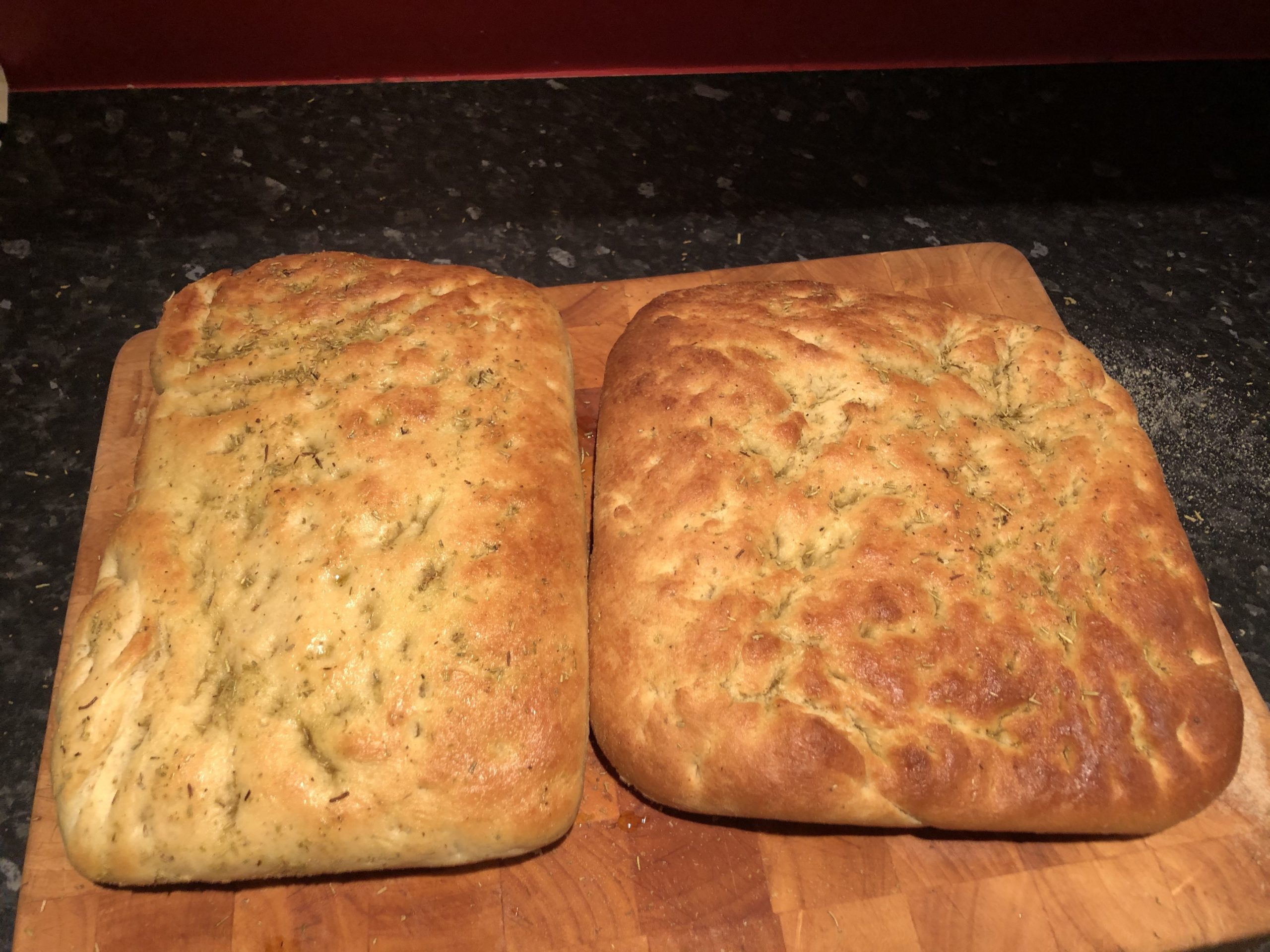
Focaccia Bread has been a family favourite for years now. My son Liam makes it too and we love it. It can be plain or add a variety of toppings. These can go from simple Olive oil, rosemary and salt to thyme, basil, roasted onions, cheese, tomatoes, slices of sausage. Anything! As with all breads, the secret ingredient is patience so give this a go and enjoy.
Ingredients needed are:
500g strong white bread flour.
7g sachet of dried yeast.
200ml of lukewarm water.
100g good olive oil.
1 tablespoon caster sugar.
1 teaspoon salt.
Rosemary or thyme. Fresh is best but dried will do.
Method:
Put the sachet of dried yeast into a cup. Add 100ml of warm water and the caster sugar. Stir them together and ensure that the sugar is dissolved. Now cover with cling film and wait. You have basically woken up the yeast and fed it. It will bubble and foam. This is good, it shows it is alive. If you like then a teaspoon of honey instead of sugar is also good. Less processed sugars.
Add the olive oil to the rest of the water and stir it through.
Whilst the yeast does it’s thing, we weigh the flour. I have said 500g but a nice difference is 400g and 100g of semolina. This isn’t something everyone has in their kitchen cupboards but it is a lovely addition if you have it.
Put the flour into the mixing bowl. I use the dough hook on the mixing machine but this can be done by hand. If using the hands method then start it off in the bowl, then when the mixture comes together tip it onto the board.
Add the salt and stir it through.
now we add some flavours if you want something different. Thyme or Rosemary are great in this bread as I said earlier. A tablespoon of the herb (not ‘erb!) added to the flour at this stage will deepen the flavour of the bread.
After 15 minutes the yeast should be frothy and ready.
if using the machine then switch it on to the first speed dial and gradually add the yeast mixture. Then slowly add the rest of the water and the oil mixture. Once the dough has started to form then turn the mixture up to speed 2.
The dough should start to smooth out in appearance. This is good but doesn’t stop there. Leave it mixing for at least 10 minutes. If the dough doesn’t look to be coming together then add slightly more water, a tablespoon at a time until it binds and becomes a ball.
If using the hands then same as above add more water until the dough forms a ball. Then we begin to knead the dough. This is so important to get the gluten working. Hold the front of the dough with one hand and push it away with the other, then repeat…for 10 minutes.
Once we are happy with the kneading then we are done for stage one.
Using a brush, lightly coat the bottom of your bowl with olive oil. Place the ball of dough in the greased bowl and cover the top of the bowl with clingfilm. There should be growing room for the bread before it comes close to the clingfilm, if not get another bowl, it needs to expand.
Place in your airing cupboard and cover with towels. The heat will create bread magic.
Leave the bread now for an hour so time to tide away and have a well earnt brew after all that exercise.
Depending on what you want to use but now we get the tray, tin or whatever ready. I use an ovenproof dish, 12×8″. It must have high(ish) sides. I sprinkle either semolina or flour into the bottom. This helps with the non-stick element but also help avoid a soggy bottom…nobody wants that.
After an hour the bread should have swelled up to somewhere near double the size. Remove the cling film and punch the bread! This gets some of the air out ready for stage two.
One the worktop we push and the air out and form the bread into the rough size of the cooking tin/dish. Lift it into place spread the dough into the corners. The floured bottom also helps with this bit. Once we are happy the using the fingertips on both hands push into the dough, almost like playing the piano (imagine the solo on The Stranglers song Golden Brown, I do). Now we sprinkle with olive oil and brush it all over. This will give us a crust and add such flavour. We can add flavourings here. I add sea salt, freshly ground peppercorns and rosemary. If adding herbs then ensure that they have been in olive oil at least 10mins before we add them otherwise they will taste of nothing.
Once we are happy then loosely cover with the cling film. An idea is to lightly brush it with olive oil too to avoid sticking. Put back in the airing cupboard for another 30 mins.
With 10 minutes to go turn the oven on to 200/400 gas mark 6
After the second prove is done we then remove the clingfilm and gently place it in the preheated oven. Leave it there for 20 minutes and breathe deeply, we are nearly there. The kitchen and house will soon start to smell amazing.
After 20 minutes the bread should be done, open the oven and check. We are looking for a golden colour. As soon as we take the bread from the oven you should brush the top with olive oil.

Now the hard part…leave it to cool. A minimum of 10 minutes.

I like to get a ramakin dish and add some extra virgin olive oil and balsamic vinegar. Dip the warm bread in and ….enjoy.
I know you will love this. KH.